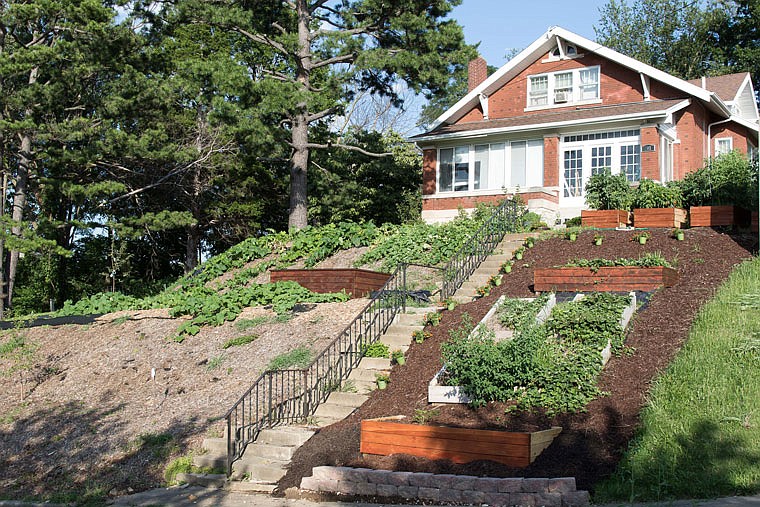Raised bed gardens have gone mainstream, now found throughout Pinterest and in favorite home magazines nationwide.
Popularity with some doesn't make for all, though, as some homeowners' associations across the country have banned front yard vegetable raised beds, while other neighborhoods have been brought closer together by the dinner-making conversation pieces.
One Jefferson City accountant is eight years into her raised bed fruit and vegetable garden, touting everything from squash and watermelon to cucumbers, peppers and tomatoes - and this is the year she may have extras.
Kortney Gentner lives on a bluff overlooking Rex Whitton Expressway and downtown Jefferson City. Her 100-plus-year-old home is literally surrounded by raised beds, starting with the steep hill up to the front door of her home, where she's planted pumpkins, a variety of squash, watermelon and more. After her lunch hour, the area has full sun - the reason she started placing beds in her front yard.
"I read about what everyone else was doing and loved the idea of an edible landscape," Gentner said. "I got the fever. I like the challenge of growing in small spaces. It all started with wanting a little kitchen garden."
So she did what she would now advise anyone interested in raising a garden to do - she went out, bought the wood and built it.
"You can build a raised bed with wood and a hammer," she said. "My first bed was just $20 worth of boards, a hammer and free compost from the city."
Perhaps the secret to Gentner's garden is the beds are filled primarily with compost - then topped with mulch, which she said makes for less watering.
"If you mulch really well, you don't really have to water often," she said. "Sweet potatoes and the plastic containers seem to need more water. I plant before it rains and mulch when I plant, and they're fine - though the sweet potatoes do get thirsty."
With her garden well established, Gentner has several systems worked out that keep her busy throughout the year. She will harvest through October, winter some of her beets and carrots indoors, and start next year's plants from seed in December in her backyard greenhouse, where she also hopes to make improvements.
She chooses what to plant based on what is practical.
"If I can get the organic pretty cheap, I won't grow it," she said. "I don't grow things that will take up a lot of space or a lot of time, like celery. A lot of it is just worth it - the acorn squash and melon just taste different."
However, her house-surrounding garden can intimidate any budding gardener. Is there anything she can't grow?
"I cannot grow corn to save my life," Gentner laughed. "I have no idea why!"
She has tried growing corn, only to have short stalks and tiny cobs, enough that she's given up on the vegetable all together.
Meanwhile, the pumpkins have already begun spilling down her front yard hill, germinated on her front concrete porch steps.
Not all of her plants start off so easily. Most Gentner grows from seed indoors on grow shelves, then she "hardens them off" in the greenhouse.
This past year, she put up more than a dozen new raised beds in her backyard, realizing along the way that she needs to maintain a place for her four dogs to do their business.
"This house was a group home before I bought it, and this was all a gravel driveway where employees would park," Gentner said. "I had a pool but realized I could turn all this space into garden with raised beds. I'm learning you can make room wherever you need."
Gentner didn't like the sand and gravel underfoot and laid mulch between the beds, where she can easily walk to examine the fruits of her labor. She placed several new wooden raised beds but also fashioned some out of round galvanized window wells that had been bolted together to make a deep, round raised bed. She noted she loves the look of the metal and wood together - and dubbed the round beds a quick and easy way to make a raised bed.
"I was so tired of cutting wood and building stuff," she said. "So I bought the basement window wells and bolted them together."
Her pets enjoy exploring her garden - though some cat action has killed some plants in the past - as do bees, birds and passersby.
"People drive down my street and slow down, looking at the garden," said Gentner, who has the only house on her block, making it apparent when someone is scoping out her creation. "I want to stop them and tell them there's more in the back!"
Gentner believes her backyard raised beds are where she has brought in some beauty, as cucumbers start to vine up somehow attractive chicken wire and wood-framed trellises, and not a dry leaf can be found, though she noted she is debating giving up on the Brussels sprouts, which the heat may have gotten to.
"We'll see how they do," she said.
Beyond her asparagus, beans, Brussels sprouts and even herbs - which she dries - she does have traditional flowers up near her home, including lilies, roses, irises and more. Also near her front door, she keeps two pots where she puts trimmings from her tomato plants, which not only are already taller than the average woman but have clippings that grow into new plants.
Looking at her dozens upon dozens of tomato plants, Gentner noted she hopes to start canning as her harvest becomes the largest she has had yet, but she will continue to build more so she can grow more.
But for now, "we eat what we grow," she said.

